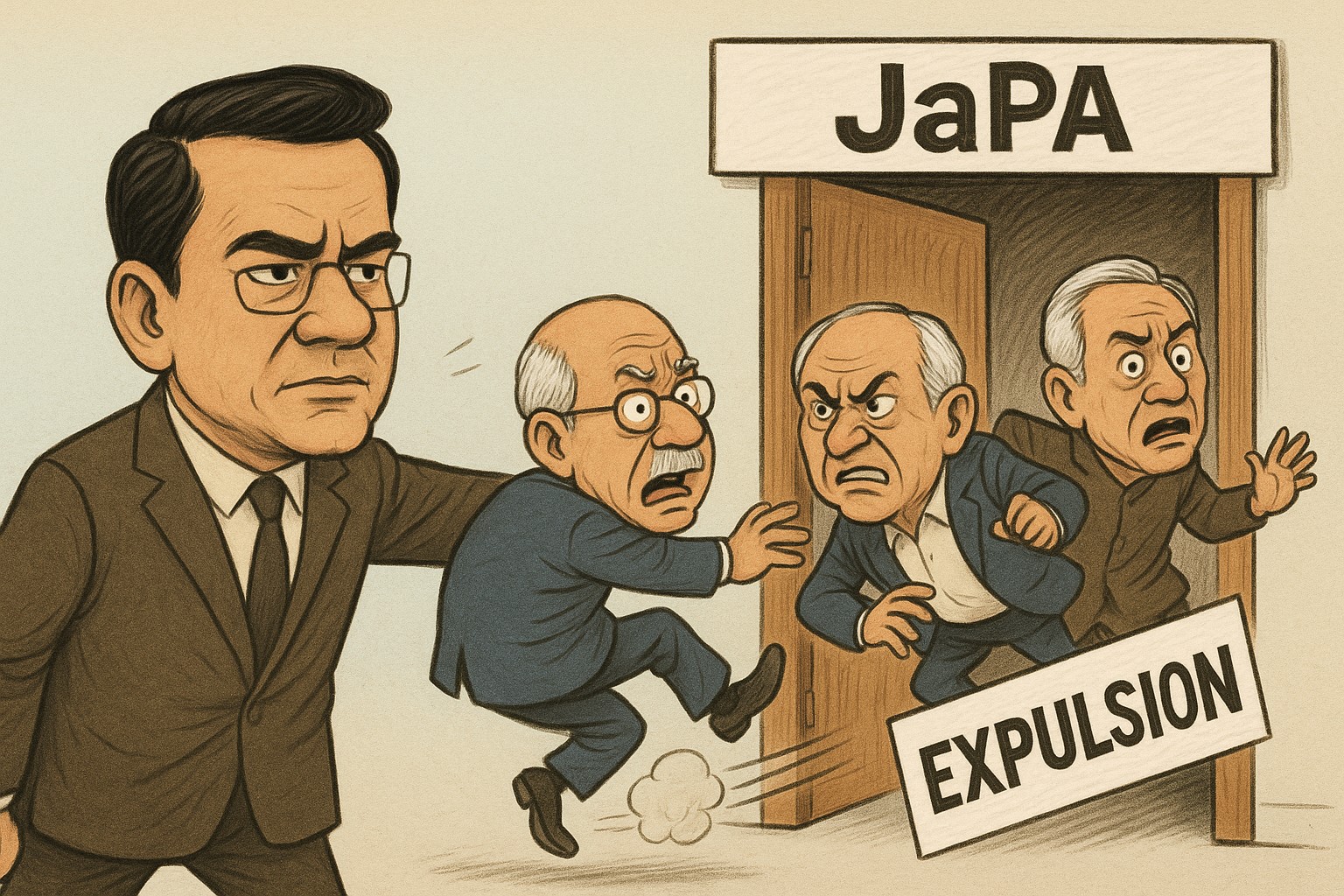The Jatiya Party (JaPa), once a formidable force in Bangladeshi politics, is now reeling from a full-scale internal collapse that has stripped the party down to a skeletal framework. The recent wave of expulsions, leadership infighting, and organisational paralysis has left the party politically incapacitated and facing an uncertain future.
Founded in 1986 by General Hussain Muhammad Ershad, the Jatiya Party once occupied a pivotal position in the country’s political landscape, often acting as a balancing force between the Awami League and the Bangladesh Nationalist Party (BNP). However, since Ershad’s death in 2019, the party has struggled to maintain relevance. Factionalism, inconsistent leadership, and strategic missteps have steadily eroded its political influence.
Under the stewardship of current Chairman GM Quader, internal fractures have widened. The latest episode in this long-standing drama unfolded on 6 July 2025, when Quader dismissed three of the party’s most senior leaders — Anisul Islam Mahmud, ABM Ruhul Amin Howlader, and Mujibul Haque Chunnu — from all party positions. These firings followed the controversial appointment of Barrister Shameem Haider Patwary as the new secretary general, a move that bypassed broader party consultation and sparked significant dissent.
In total, ten leaders, including seven presidium members, were removed in what has been described as a political purge. The stated justification was a “breach of party discipline,” yet critics within the party view it as an authoritarian manoeuvre to silence opposition and consolidate power.
Critics argue that GM Quader’s leadership style has grown increasingly autocratic. Decisions of national significance have reportedly been made unilaterally, with little to no consultation with key party stakeholders. The abrupt removal of high-profile leaders without due process has drawn sharp rebukes from within the party, with expelled leaders labelling the move undemocratic and destructive.
Factionalism has long haunted the Jatiya Party, but the current wave of infighting is unprecedented in its scope and severity. Since the 1990s, the party has seen repeated splits — including in 1997, 1998, 2001, and 2013 — and most recently in April 2024, when Rowshan Ershad, the late chairman’s widow, led a breakaway faction. The present crisis fits into this historical pattern, though the scale of institutional damage this time is significantly more profound.
Adding fuel to the fire is the perception that Quader has grown too close to the former ruling Awami League. Many party members believe this association has undermined JaPa’s role as a legitimate opposition force and alienated its core support base.
Organisational collapse
The party’s inability to function on a basic organisational level further illustrates its decline. A national council scheduled for 28 June 2025 had to be cancelled due to internal disagreements and logistical chaos. Plans for a major rally were also scrapped, exposing the party’s weakened capacity to mobilise supporters or deliver a coherent public message.
The recent defection of Didarul Alam, a senior party leader in Chattogram, to Bangladesh Jamaat-e-Islami underscores the crisis of confidence within JaPa’s ranks. His departure is a bellwether for what could become a broader trend if the current trajectory continues.
The firing of leaders like Anisul, Howlader, and Chunnu has not only removed seasoned politicians with deep grassroots connections, but also disrupted the already fragile chain of command. Their absence leaves a leadership vacuum that Quader’s inner circle may struggle to fill.
The fallout has been immediate and damaging. The central committee has been hollowed out. The remaining leadership lacks both public legitimacy and internal unity. Public trust has plummeted, and the party’s standing as a viable electoral force is now seriously in question.
The weakening of the Jatiya Party also carries broader consequences for opposition politics in Bangladesh. In a landscape already dominated by the Awami League and the BNP, a fragmented third party removes any semblance of a centrist alternative. This vacuum could be exploited by fringe or ideologically rigid parties, such as Jamaat-e-Islami, further complicating the national political equation.
Moreover, the party’s inability to act as a stabilising force or unite splintered opposition voices leaves Bangladesh’s political discourse more polarised than ever.
What’s next for the Jatiya Party?
The road ahead for the Jatiya Party is steep and uncertain. To survive — let alone regain relevance — the party must first address its internal dysfunction. This includes restoring democratic norms within its ranks, reconciling with estranged factions, and rebuilding trust with its grassroots supporters.
However, the current leadership’s posture suggests little appetite for compromise or institutional reform. If GM Quader continues down the path of centralised control and exclusion, the party may face either complete collapse or yet another major split.
There is also the looming challenge of the next general election. With no clear leadership, low morale, and an eroded support base, the Jatiya Party appears woefully unprepared to contest — let alone win — in a meaningful way. Its fading presence on the political stage risks rendering it irrelevant in the national conversation.
The meltdown within the Jatiya Party has done more than disrupt leadership — it has exposed the party’s structural fragility, political drift, and crisis of identity. Reduced to a skeleton of its former self, JaPa now stands at a crossroads. Without immediate reform, inclusive leadership, and a bold redefinition of its purpose, the party risks not only irrelevance but political extinction.


